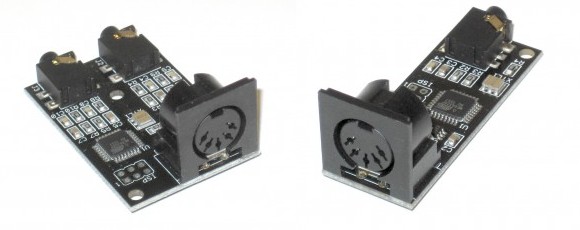
This pair of dongles is a fun way to get your feet wet working with MIDI hardware. They’re called MIDIvampire-I and MIDIvampire-II. Just plug one end into your MIDI-ready instrument and the other into a pair of speakers and you’re off and running. Mark I is a polyphonic synth, and Mark II is a drum machine, but both use basically the same hardware which you may already have on hand.
The single chip on each board is an ATmega328 often found anchoring Arduino boards. The other silicon component is an S1112B30MC voltage regulator. The rest of the components are passives, with MIDI and headphone jacks for connectivity. They’re selling these if you want the easy way out, but we thought we’d bring them to your attention in case you needed a breadboarding project this weekend. The firmware, BOM, schematic, and board artwork are all available on the Wiki pages linked in the articles above. After the break you can see a couple of demo videos which walk through all of the features.















This one is exactly what I have been putting up to later for a few years.
I’ll try to adapt it ASAP, opening the computer can be a drag when trying just to play a bit with the keyboard. After that, adding a small sequencer …
No opto coupler?
Can any body explain why they run it on 8 mhz instead of 16?
Very nice synth going to be building one of these.
possibly because they run on 3V and don’t believe their controller runs stable. maybe also energy usage.
Haha… Arduino much?
A ‘328 is specced for 20MHz at 5 volts, not 16 as the Arduino crowd has led us to believe.
The lack of Opto threw me for a minute, until I realized there is no power jack either.
The boards draw their power from the MIDI cable, and without a power supply to cause problems, they can get away without the optoisolator.
drawing power from the midi cable is a bad thing as there’s no guarantee you get power while not playing any notes, unless you keep some midi/sync signal running continuously. Also, the required opto at the input is there to keep grounds separated, which this project does not. Believe me, you don’t want your laptop ground connected to an expander signal ground when playing live.
A very nice project, but needs to be more close to the standard.
MIDI signals drive the line high to indicate zeroes in between notes, so there IS a guarantee you get power while not playing notes, even though there is no sync signal running continuously.
Neat project.
If you can find one then an old Creative Waveblaster expansion board can be easily turned into a standalone synth and also sounds a lot better with nearly full GM support. The boards are pretty expensive now though as they’re just so old so pretty scarce.
If you’re okay with the sounds from the MIDIvampire then this will be a very simple and cheap alternative.
I’ve always been baffled that the MIDI type connector is called DIN for Deutsches Institut für Normung, because they really are poor connectors in my view so you’d expect something better originating from germany.
Although it’s pretty damn old, they already has them in WW2.